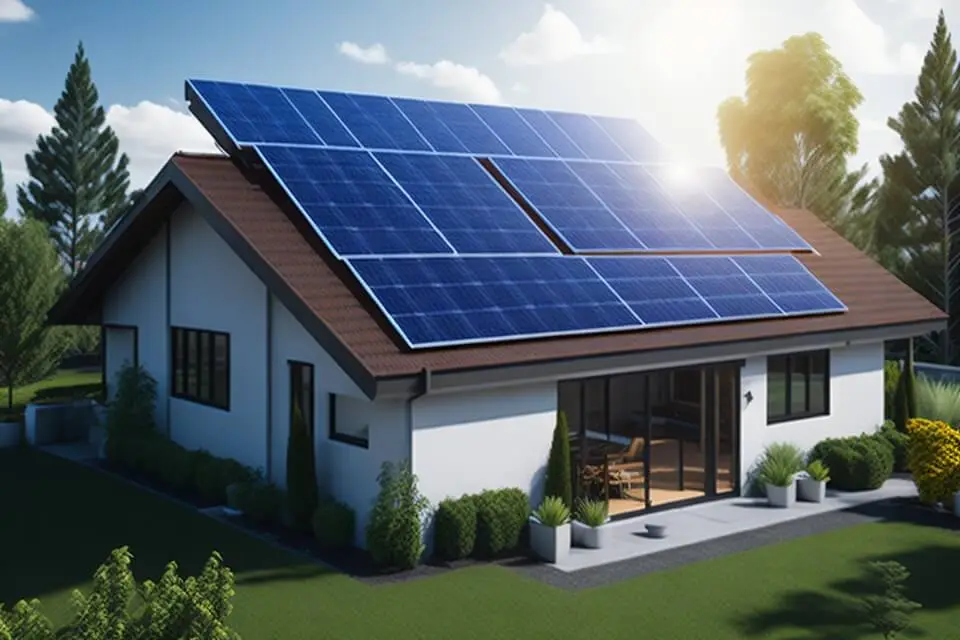In a world driven by sustainability and innovation, the journey toward adopting solar panels is a fascinating exploration. Melding environmental consciousness with economic pragmatism.
Beyond the initial expenses, we delve into the tangible and intangible gains that echo through time. Revealing a compelling narrative where environmental stewardship and financial prudence harmoniously converge.
Solar Panels Unveiled: The Art of Passive Power Generation
In a world where progress is often accompanied by the hum of machinery, solar panels stand as a remarkable exception. These silent sentinels of renewable energy exemplify the elegance of passivity.
This brings many advantages stemming from their lack of moving parts and minimal maintenance requirements. This absence of mechanical complexity not only enhances reliability but also eliminates the cacophony of maintenance challenges.
The occasional sweep of a soft brush or a rinse with clear water bestows these panels with their full splendor. Unlike the demanding routines of mechanical systems, solar panels beckon us into a realm of simplicity and ease.
Recent Technological Improvements in Solar Panel Fabrication
- Thin-Film Solar Panels: Advancements in thin-film technology have led to panels that are more lightweight, flexible, and adaptable to various surfaces and structures.
- Tandem Solar Cells: Tandem solar cells integrate multiple layers of photovoltaic materials to enhance energy conversion efficiency by capturing a broader spectrum of light.
- Bifacial Panels: Bifacial panels, designed to absorb sunlight from both sides, increase energy generation by utilizing reflected and diffused light, especially in environments with reflective surfaces.
- Perovskite Solar Cells: Perovskite cells demonstrate exceptional energy conversion efficiency and potential for cost-effective manufacturing, presenting a promising alternative to traditional silicon-based panels.
- Transparent Solar Panels: Transparent solar technology allows windows and building surfaces to generate electricity without compromising visibility, offering a dual-purpose solution.
- Double-Glass Modules: Solar panels with double-glass construction enhance durability and weather resistance.
- Bifacial Tracking Systems: Advanced tracking systems enable bifacial panels to follow the sun’s trajectory, optimizing energy capture throughout the day.
- Anti-Reflective Coatings: Coatings that minimize light reflection and enhance light absorption increasing overall efficiency.
These technological improvements collectively showcase the relentless pursuit of higher efficiency, enhanced durability, and increased adaptability, propelling solar panel technology into a new era of sustainability and energy generation.
This Is How The Generated Solar Panels’ Energy Used
The utilization of energy generated by solar panels involves a systematic process that transforms sunlight into usable electricity for various applications. This intricate progression encompasses several stages, each contributing to the efficient conversion, distribution, and consumption of the harnessed solar energy.
- Photon Absorption and Electron Excitation: This process creates electron-hole pairs, generating a flow of direct current (DC) within the cell.
- Conversion to Alternating Current (AC): The direct current generated by the solar panels is inherently in DC form. The inverter transforms the DC electricity into AC electricity, aligning it with the standard electrical format.
- Electrical Grid Integration: This integration allows the generated energy to be shared with neighboring homes, businesses, or the wider community, facilitating the efficient distribution of surplus energy.
- Net Metering and Energy Flow: In grid-connected setups, net metering mechanisms play a pivotal role. Excess solar energy generated during periods of high sunlight is fed back into the grid, causing the electricity meter to run in reverse.
- Energy Consumption: Energy consumption occurs seamlessly, with solar-generated electricity being prioritized to meet immediate demands. This process can significantly reduce reliance on grid-supplied electricity, leading to energy cost savings and a reduced carbon footprint.
- Energy Storage (Optional): In cases where energy storage systems, such as batteries, are integrated into the solar setup, excess solar energy can be stored for later use.
- Remote Applications: Beyond grid-connected scenarios, solar-generated energy can be used in remote locations where grid access is limited.
In summation, the energy harnessed by solar panels undergoes a carefully orchestrated transformation from sunlight to electricity. integrating seamlessly with the electrical grid and various applications.
The Average Cost of a 6 kW Solar Panel Setup
For this example, I am taking a 6 kW setup because this can perfectly cover a house’s needs. Certainly, some criteria should be met, like an average of 5 hours of sunlight per day.
On average, the cost of a residential solar panel system in the United States can range from $2,500 to $3,500 per installed kilowatt (kW) before incentives. Therefore, a 6 kW solar panel system could cost anywhere from approximately $15,000 to $21,000 before any rebates, tax credits, or incentives are applied.
It’s important to consider various factors when estimating the cost:
- Location: Solar costs can vary by state and even by city due to differences in labor costs, permitting fees, and local regulations.
- Incentives: Federal tax credits, state incentives, and local rebates can significantly reduce the upfront cost.
- Quality and Brand: The quality of solar panels, inverters, and other components can impact the cost.
- Installation: Labor and installation costs can vary based on the complexity of the installation, roof type, and other factors.
- Additional Costs: Other costs may include permits, equipment upgrades (if needed), and any electrical work required to connect the system to your home.
- Market Conditions: Solar panel prices can fluctuate based on supply and demand dynamics in the market.
It’s recommended to obtain quotes from multiple solar installation companies. They can provide you with customized cost estimates based on your energy consumption, location, and available incentives.
How Much Energy Can This Setup Produce Per Month
Let’s delve into a tangible example that vividly illustrates the energy production prowess of solar panels. Imagine a residential rooftop adorned with a 6 kW solar panel system, situated in a region where the sun graces the panels with an average of 5 hours of direct sunlight per day.
This equates to daily energy production of 6 kW * 5 hours = 30 kWh. Over the course of a month, this robust solar setup generates approximately 900 kWh of electricity, significantly offsetting the household’s energy consumption.
How Much Does This Produced Energy Cost?
As of February 2023, the average residential electricity rate in the U.S. is about 23 cents per kilowatt-hour (kWh). Importantly, electricity rates can vary widely based on where you live. Rates vary from a low of 10.35 ¢ / kWh in Idaho to a high of 28.38 ¢ / kWh in California.
To estimate the cost, you can use the following formula:
Cost = Energy Usage (kWh) * Electricity Rate (per kWh)
Let’s assume an average electricity rate of 20 cents per kWh:
Monthly produced energy value: 900 kWh/month * $0.2/kWh = $180/month
Therefore, the approximate cost of consuming 900 kWh of electricity per month at an average rate of 20 cents per kWh would be around $180. Keep in mind that electricity rates can vary significantly based on your specific location and the time of year.
Cost Calculations at a Glance
Let’s see what are the average figures for our 6kW setup example and if it is worth it.
- Hardware and setup cost for a 6kW setup: ~$18,000 / One time.
- Value of the energy produced per month with 5 hours of sun per/day: $180.
- Value of the produced energy in a year: $180 * 12 = $2,160.
- Years for the return on the initial investment: ~8 years.
We should also keep present that there might be federal reimbursements and other financial support for covering the initial investment.
Is it worth it? Absolutely yes, in the long run, it is practically free energy. Add to the considerations the environmental impact, you’ll be producing the greenest energy.
To read more about green energy production and efficiency check our article on The Wind Tree: Revolutionary Wind Power Harvesting, But Is It Worth It?
Conclusion
In closing, the undeniable allure of solar power comes sharply into focus. While initial expenses might raise eyebrows, they quickly yield the enduring benefits that unfold over time.
A fortunate alignment emerges as traditional energy costs climb higher. Casting a spotlight on the rapid growth and evolving technology of solar panels. This synchronicity of circumstances presents a compelling argument. Not just as an ecological imperative, but as a savvy financial choice.
As each day dawns, the solar sector gains momentum, riding the waves of technological innovation. It’s a journey marked by sustainable savings and a brighter future, where the sun’s energy, once harnessed, becomes a beacon of lasting prosperity and environmental responsibility.





